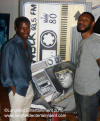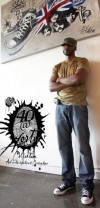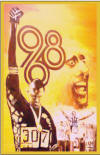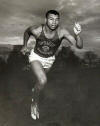|
Mark “Kurupt” Stoddart: Visual Communicator
Source: Dawn Langfield, Langfield Entertainment
Mark Stoddart
– very closely synonymous with a
renaissance man. I sought him
out because of one of his latest works – the tee shirt
you may have come across on Facebook. The same tee shirt that many
prolific and talented Canadian artists and industry folks have
been photographed wearing. What was this about? What’s the
‘movement’ behind it? Seemed simple enough to me but what I
uncovered after witnessing a photo shoot and the plethora of
artists coming through his doors to get involved, was a story
about a man giving back to his community. latest works – the tee shirt
you may have come across on Facebook. The same tee shirt that many
prolific and talented Canadian artists and industry folks have
been photographed wearing. What was this about? What’s the
‘movement’ behind it? Seemed simple enough to me but what I
uncovered after witnessing a photo shoot and the plethora of
artists coming through his doors to get involved, was a story
about a man giving back to his community.
Some of you have known about Mark
Stoddart, also known as “Kurupt”,
for years. This talented
visual artist has many accomplishments behind his name, has
worked tirelessly to give
back to community, has impacted lives and discusses here his
story and the
motivation that propels him forward.
Mark’s life took a dramatic turn in 2005 when his friend,
Shawn "Blu"
Rose, died suddenly. Blu was a
cherished youth worker in Scarborough's Malvern neighbourhood. His work was valued so extensively within the
community that Malvern renamed a park, formerly called Empringham Park, to Shawn "Blu" Rose Park in his honour.
Mark has
played international professional basketball (and now
coaches), had a career as a talented and successful graphic designer (and
now mentors), and today is a
visual communicator through his art as a social and political
activist. successful graphic designer (and
now mentors), and today is a
visual communicator through his art as a social and political
activist.
What is the origin of your name “Kurupt”?
Wow - high school in 1988-89. I had a ‘conflict of interest’ in
dealing with one of my art teachers. I finally hit my
breaking point where I said, enough is enough. I lashed out. He was looking for a reason to get me
out of the
school. But my Mom was NOT having it.
So, I got suspended for
threatening that teacher after he called me “corrupt”. My Mom
was called and she told them that her
“son has never been corrupt”.
My Mom went to bat for me.
But in contrast, I had the support of Mr. Rouillard, who is one
of my mentors, who liked me and was so supportive of where I
wanted to go with my art. He protected me.
Then I started thinking about conflict
and that word ‘corrupt’ - and society - and how two negatives
can make a positive. And that’s who I am … because I’m still
trying to make a positive difference.
It’s interesting because that name doesn’t seem to go with who
you are and what you do.
Right – it’s a conversational piece that I want people to
understand. And that’s the only reason why I use that name. People often think I’m using the rapper’s name but nah,
it goes deeper than the rapper’s name. I always say my Mom gave me that name and it was
based off that story from school.
name. People often think I’m using the rapper’s name but nah,
it goes deeper than the rapper’s name. I always say my Mom gave me that name and it was
based off that story from school.
Further, my first business success was through the music
industry - BMG, Sony, Universal, Saukrates, the Rascalz, Ghetto
Concept and MuchMusic (web design). I
designed all their stuff. My business name was
Kurupt Designs.
They’d say “oh Kurupt is doing our work”. It’s something that
people remembered. But when you really get to know me,
I’m not corrupt at all. I’m this guy that’s doing
something positive. It just ties in with a negative turned into
a positive. That’s where the name comes from. That’s
the first time I’ve told that story.
What is the root of your commitment to giving back? Is it a
spiritual thing? Community-based?
It’s both spiritual and community based. We need to leave
something behind, a legacy of who we are. The only way is to
give back so that people can follow that blueprint. I think
it’s essential for the kids coming up now to understand. There
are plenty of avenues of success and I’m just trying to give
another option so that the youth can identify with that.
The
only way to leave a legacy is to give back.
As a young man,
you played basketball at Sheridan College in Oakville. How did
you come to play professionally in the UK?
Scarborough’s a
small pond of people but you build a reputable name of who you
are and then you go to a bigger pond, college. I took art
courses because I wanted to be an illustrator but as far as
basketball, I had to earn my stripes. I had to understand my
position and I learned the system but that learning curve was
difficult for me.
Again, just to be part of that team was something ... and then we
won nationals! Two years ago, they honoured the alumni of that team in the Hall
of Fame at Sheridan. bigger pond, college. I took art
courses because I wanted to be an illustrator but as far as
basketball, I had to earn my stripes. I had to understand my
position and I learned the system but that learning curve was
difficult for me.
Again, just to be part of that team was something ... and then we
won nationals! Two years ago, they honoured the alumni of that team in the Hall
of Fame at Sheridan.
I eventually came to a crossroads
where I had to ask myself, “Am I going to go pro in this? No.”
I went to Sheridan for art and not basketball. I told my coach
that it just wasn’t for me anymore and he respected my decision.
Then I graduated and went to into the workforce and into the
matrix of the 9-5.
It just wasn’t my calling.  I wanted to go to Europe (Nottingham) just to
get away. I’m a citizen so the transition was easy for me.
Nottingham had a basketball team and they wanted me to be part of their squad. So I
played for one year but playing at the professional level wasn’t
for me. That led to me coming back (to Toronto) and working
in graphic design.
I wanted to go to Europe (Nottingham) just to
get away. I’m a citizen so the transition was easy for me.
Nottingham had a basketball team and they wanted me to be part of their squad. So I
played for one year but playing at the professional level wasn’t
for me. That led to me coming back (to Toronto) and working
in graphic design.
How did you come to coach?
One of my greatest friends,
Chris Smalling
invited me to be an assistant coach with him at Centennial
College.
Chris and I grew up together from high school and he’s been a
good friend. Our kids were kind of unruly but I think
they respected us. We ended up in a tournament against Sheridan
College, my old alumni, on my birthday! And we beat
them! I was ecstatic! We weren’t even ranked very highs and we
beat them!
That was one of the best moments in my life.
Everything comes full circle.
Then the Alumni Association of Sheridan asked me to come back
and talk to the graduating students. I guess because of where I
am now, there was something about my journey that they wanted me
to tell. I was scared as
hell because I don’t like public speaking - but we have to
conquer our own fears. That’s the first time I realized that I have a voice.
I told the kids that we
have the ability to create our own goals. You just have to find out
what that is. [Full speech
HERE.]
because of where I
am now, there was something about my journey that they wanted me
to tell. I was scared as
hell because I don’t like public speaking - but we have to
conquer our own fears. That’s the first time I realized that I have a voice.
I told the kids that we
have the ability to create our own goals. You just have to find out
what that is. [Full speech
HERE.]
How did the idea
of the Live It Wear It campaign come up? Why this symbol and why now?
One of the stories that most
people don’t know was that in the early 90’s, I met Kwame Ture
also known as Stokely Carmichael. He was the person that coined
the phrase
‘Black
Power’.
He was part of Dr. King’s movement and the Black Panthers. So
that was where my conscientiousness was and it has never
changed.
Kwame Ture
also known as Stokely Carmichael. He was the person that coined
the phrase
‘Black
Power’.
He was part of Dr. King’s movement and the Black Panthers. So
that was where my conscientiousness was and it has never
changed.
But it has been sparked again perhaps because of the
election of the first Black President in the United States.
I thought it was time to bring that imagery to the forefront again.
I have a theory about why I think this campaign is doing so
well. Not many people know this but my friend Kwame Parker’s
father,
Don Parker,
was one of my mentors and always supported my art. He collected
all the tee shirts that I used to make. He was an integral part
of my life. He recently passed away and I put the first shirt
of this campaign in the coffin with him. It was a respect thing
and to pay homage to him for all his love and support over the
years. My theory is that because I gave the shirt back to
the earth with him, that it’s become something special and
something that people can identify with, even if they don’t know
why.
How did you end up linking with the mega-talented
Nathaniel Anderson
as your photographer for this project? The campaign is
really based on those photos and the emotion they provoke.
It seems to me it is both your gifts coming together to make a
special campaign.

Nathaniel has been a constant. I always say this and he laughs
- but I’m like a Pinto, and he makes me become
the Bentley. There’s some photographers out there that are
well-known and doing their thing. But Nathaniel has the ability
to make things come to life. He has the ability to capture
someone right in the moment. I call him the time-stopper
because he can stop time with his camera and capture who
you are and take notice of who you are. Our mutual friend, Orla,
introduced us and from then there was some sort of chemistry.
We all lived in Scarborough but we never interacted or crossed
paths. It’s all about timing. Certain people you just know
you’re going to bond with.
What’s the significance of 1968 on your tees?
1968 was a year for a lot of things to happen. There was a lot
happening in the civil rights movement in the United States. At
the Olympics in Mexico City, two American brothers won the 200
meters. Tommie Smith and John Carlos, when accepting their
medals, made that gesture (puts closed fist in the air) that
people embraced. It changed the course of who they were and
made it an iconic symbol. Also in 1968, Dr. King was
assassinated. In Canada, Lincoln Alexander because the first
Black Lt. Governor.
And it’s also the year I was born.
It was a powerful year to be born. That tells my story about
what I want to do in telling stories as an artist.
[Video clip of 1968 Olympics and iconic gesture by Tommie
Smith and John Carlos
HERE.]
How did it come to be that you were commissioned as an artist to
create paintings for Converse shoes? Was that first or was your
40@40 Collection first?
Mark’s 40@40 Collection’s goal was to create 40 paintings of
significant black musicians and athletes before the arrival of his 40th birthday in 2009. His initial paintings
include jazz icons Jimi Hendrix, Dizzy Gillespie, Miles Davis,
John Coltrane and Ray Charles. The sports icons in his
collection include but are not limited to, Jim Brown, Bill
Russell, Wilt Chamberlain, Satchel Paige, Tommy Smith and Fergie
Jenkins.
arrival of his 40th birthday in 2009. His initial paintings
include jazz icons Jimi Hendrix, Dizzy Gillespie, Miles Davis,
John Coltrane and Ray Charles. The sports icons in his
collection include but are not limited to, Jim Brown, Bill
Russell, Wilt Chamberlain, Satchel Paige, Tommy Smith and Fergie
Jenkins.
In addition to the 40@40 collection, Stoddart was commissioned
to create a one-of-a-kind painting for the leading footwear
brand
Converse, featuring their popular Chuck Taylor footwear, with
images of rock icons Ozzy Osbourne, Pink Floyd and The Who
integrated into the design for Converse Canada’s 100th birthday.
The Converse opportunity came out of my relationship with Chris Smalling again, whose kids were in a
basketball camp that I was involved with, which was sponsored by
Converse.
They were doing a celebration for the century. I told them my
concept and they liked where I was going. I brought
Nathaniel
(Anderson)
in to get on board too. It was also
about building relationships with the right people at the right
time. What I did was take the texture of the
sole bottom of the
shoes
and allow them to be the texture of my paintings. You have to be
grimy in your stuff. You have to make your own imprint even if
it seems twisted and weird. Sometimes you have to go against
the grain.
What do you consider your ‘big break’ moments? When you knew
that your career as an artist was being lifted to the next
level?
The biggest affirmation for me was going through my old sketch
book from college and
seeing a sketch I did of
Kwame Ture.
He was in Toronto doing a speaking engagement and I went and he
signed my sketch book and it said
“Everything
for the people, even art Mark”.
It showed that whatever I do is still relevant and that I have a
story to tell our people.
One of my major pieces is called “The Silent Gesture”
and within
that image, you have Tommie Smith winning the race and in the
scenery you see Kwame Ture speaking. I wanted to tie that all
in along with the symbol of 1968. That piece was a tribute to
him and it actually put me back on my journey.
As an artist, it is my duty to give back.
It’s great to have relationships with people that have their own
way of telling stories. I’m just blessed to be that vessel that
channels the energy which allows me to create these things.
There’s moments that stand still for me and I know that it’s not
just about me anymore.
What’s next for Mark Stoddart?
You have to be forward thinking as a visionary, which is no
small feat and leaves behinds a bright legacy. Your lifespan
is short as a visionary – you’re not hitting 80 or 90 years
old. Your time is limited because so much is being forced out of
us. It’s like a burning star. I know that there’s a lot
more to come out before my time is up that is going to be impacting
people’s lives but I can’t let the cat out of the bag just yet.
[In 1988, while Mark Stoddart was still in high school, he was
nominated for a
Harry Jerome Award
for Excellence in Arts. Come full circle, again, and in 2010, Mark
is creating a painting series on the life of Canadian
track and field star, activist and icon
Harry Jerome
for a documentary being directed by
Charles Officer.
From
Facebook.com:
Excellence in Arts. Come full circle, again, and in 2010, Mark
is creating a painting series on the life of Canadian
track and field star, activist and icon
Harry Jerome
for a documentary being directed by
Charles Officer.
From
Facebook.com:
"This film is long overdue and will give people a real sense of
what Harry Jerome means to Canada," says Mark Stoddart, a
Toronto-based artist who has been commissioned to create a
portrait of Jerome. "It is about time that all Canadians
understand the impact of Harry Jerome and his iconic status as a
true Canadian hero."]
What do you want people to remember you for?
A brother that is doing what he said. I just want to be a
brother that is known as a giving guy that put in the work. If
you have something you believe in, then stick it out. There’s
going to be a lot of bombs and a lot of sacrifices but believe
in your craft and you will see the fruits of your labour.
Thank you to Mark and Nathaniel for their generosity of spirit, time and sharing
the story.
Web Links:
www.liwi68.com
www.mstoddart.com
www.nathanielinc.com
www.facebook.com/Nathaniel.Incorporated
|